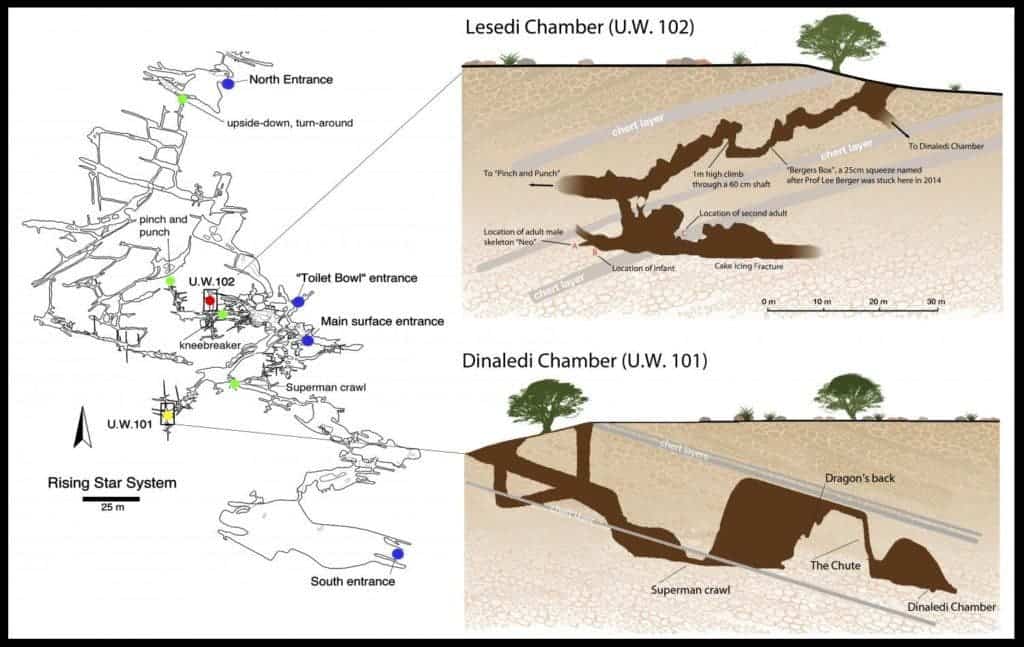Scientists have described a new haul of ancient human remains from an extremely intriguing cave site in South Africa. The newly published study focuses on the newly-identified species Homo naledi, showing that despite having a brain three times smaller than our own, they exhibited some surprisingly advanced behavior.

Unlike Neanderthals, Homo naledi, which was first announced in 2013, is not exactly the closest relative to modern humans. It exhibits some very primitive traits, which is why researchers were surprised to see that it lived until quite recently — just 235,000 years ago. This means it might have overlapped with the earliest Homo sapiens. In order to reach this age, researchers dated not only the bones themselves but also the sediments on the cave floor and flowstones — carbonate rocks formed from calcium-rich water flowing through the cave. Two separate labs performed the dating “blind,” not knowing what they were analyzing and what the other lab was doing. This means that this is one of the best-dated sites in Africa and in the world.
It all started when researchers reported the finding of 15 individuals of various ages were discovered inside the Dinaledi chamber – part of South Africa’s Rising Star Cave system. It didn’t take long for scientists to discover another chamber, a mere 100m away from the first one — also riddled with Homo naledi remains. A study describing the first chamber was published in 2015, but the second chamber (the Dinaledi chamber) was only detailed now, in not one, but three different studies. Prof Lee Berger from the University of the Witwatersrand in Johannesburg, Prof John Hawks from the University of Wisconsin-Madison, Professor Paul Dirks of James Cook University, and their collaborators report abundant fossils, including one of the most complete skeletons of a hominin ever discovered, as well as the remains of at least one child and another adult.
“The dating of naledi was extremely challenging,” noted Dirks, who worked with 19 other scientists from laboratories and institutions around the world, including labs in South Africa and Australia, to establish the age of the fossils. “Eventually, six independent dating methods allowed us to constrain the age of this population of Homo naledi to a period known as the late Middle Pleistocene.”

This just goes to show the incredible hominin diversity going on at the time:
“Here in southern Africa, in this time range, you have the Florisbad skull, which may be an ancestor or close relative of modern humans; you’ve got the Kabwe skull, which is some kind of archaic human and possibly quite divergent; you’ve got evidence from modern people’s genomes that archaic lineages have been contributing to modern populations and may have existed until quite recently,” said Prof Hawks.
“You have this very primitive form of Homo [naledi] that has survived alongside these other species for a million years or more. It is amazing the diversity that we are now seeing that we had missed before.”
But perhaps more importantly than that, they shed an interesting light on the ‘new’ species. For starters, despite being quite primitive, they apparently filled the same ecological niche as humans and Neanderthals. Based on their teeth, archaeologists and anthropologists believe they had quite a similar diet, which is intriguing.
“It doesn’t look like they’re in a different ecological niche. That’s weird; it’s a problem. This is not a situation where we can point to them and say: ‘They co-existed because they’re using resources differently’,” Prof Hawks told BBC News.
Since there was no visible geographic barrier between them and other hominin species, there’s a good chance there was some level of interaction between the species, although evidence for this hasn’t been found. But this makes things even more intriguing because Homo naledi somehow kept its primitive features — despite living alongside other Homo species for up to two million years.
But it gets even better. Researchers also found tools and a burial site in the cave. Previously, it was thought that a more advanced species created the tools, but having found what seems to be a naledi burial site, the cognitive capacity of the species can no longer be underestimated. In fact, the whole reason why so many fossils were found is because the second chamber was basically a big burial site. It seems that at the time, it was a dark, hidden chamber which the naledi seem to prefer for burials.
“We can no longer assume that we know which species made which tools, or even assume that it was modern humans that were the innovators of some of these critical technological and behavioural breakthroughs in the archaeological record of Africa,” says Berger. “If there is one other species out there that shared the world with ‘modern humans’ in Africa, it is very likely there are others. We just need to find them.”
So this exciting new discovery brings even more questions than it answers. Where does the new species fit in the evolutionary tree, how did it interact with other hominins, and perhaps the most challenging one: how was life for Homo naledi? There’s decades of research fitted into those questions, and researchers are making sure that nothing gets damaged and everything is excellently prepared for future studies.
“We are going to treat ongoing extraction of material from both of these chambers with extreme care and thoughtfulness and with the full knowledge that we need to conserve material for future generations of scientists, and future technological innovations,” he says.
You can read all the papers published on Homo naledi in the journal eLife. Journal Reference:
- Paul HGM Dirks et al. The age of and associated sediments in the Rising Star Cave, South Africa, eLife (2017). DOI: 10.7554/eLife.24231
- John Hawks et al. New fossil remains offrom the Lesedi Chamber, South Africa, eLife (2017). DOI: 10.7554/eLife.24232
- Lee R Berger et al. , a new species of the genusfrom the Dinaledi Chamber, South Africa, eLife (2015). DOI: 10.7554/eLife.09560


